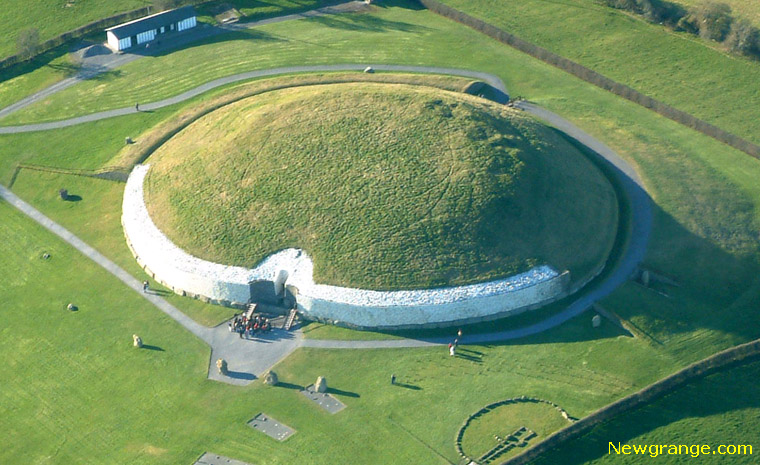Cracking the Newgrange Code - Martin Brennan - Page 4
 I looked at the measuring rod I held in my hand. In Greek, gnomon means "the one who knows". Could the Boyne Valley measuring system itself be
derived from sundialling and could this measuring rod in fact be the gnomon? I was startled by what I found out at the drawing
board. At the latitude of Newgrange a shadow cast by an A gnomon
is the length of a B at noon of the equinoxes. This means that the very basis of the measuring system extends from this moment of time.
I looked at the measuring rod I held in my hand. In Greek, gnomon means "the one who knows". Could the Boyne Valley measuring system itself be
derived from sundialling and could this measuring rod in fact be the gnomon? I was startled by what I found out at the drawing
board. At the latitude of Newgrange a shadow cast by an A gnomon
is the length of a B at noon of the equinoxes. This means that the very basis of the measuring system extends from this moment of time.
The significance of this is that on a star map, this moment of time is called "the first point of Aries" and there is a practical reason why the ancient astronomers used this as a starting point for astronomical measurement which is the same reason why it is still used by modern astronomers today. It would defy the limits of the imagination to suggest that it was known during the Stone Age, yet, it is impossible to escape this conclusion. A large number of stones which I examined revealed that the grid system used is based on angles derived from the position of the celestial pole using a gnomon of the C measure. A number of factors eliminate all possibilities of coincidence.
Sundialling is by its nature a very precise are and an exact science. The gnomon does not lie. The grid and its measurements appear much too often to allow any room for the chance that there wasn't a deliberate and conscious effort not only to record astronomical knowledge but to build huge monuments that would be capable of transmitting this knowledge to a different culture thousands of years in the future. Thus they constructed a kind of time capsule preserving their achievement.
If we can visualise Newgrange as a scientific instrument for a moment, we can get a glimpse of what it actually is. As a sundial it measures the solar year to within seconds. Regardless of how specialised it is, it is the world's oldest sundial and at the same time, the world's largest.
It is the oldest scientific instrument in the world that is still functioning and it will continue to function for all conceivable time regardless of minor changes in the tilt of the earth's axis. (It is designed to take this into account). Predating Stonehenge and the pyramids, it stands as one of the world's most ancient monuments. It is quite likely that it will still be functioning when our own scientific instruments have turned to dust. We have a great deal to learn from it.
Even at the early stages of my investigation into its mysteries I had learned to respect the mind of megalithic man. Working independently from Professor Thom. I came to this similar conclusion: "We must no longer assert that these people could not possibly have known this or done that ". These people are not barbarians, they are not grave-diggers and they do not make magico-religious symbols. Their symbols appear to us as magic because we haven't understood their technology, just as our technology appears as magic to primitive people.
It appears to me that these people pioneered empirical scientific thought and established the first great civilisation. It is now also apparent that science, art and religion were a single field of endeavour to them and they did not suffer from departmentalisation as we do. They saw the stars as making great circles in the heavens and they observed that planets seem to move along a lie describing the ecliptic like spirals, much like the Greeks did. Examining this sort of thinking goes beyond archaeology. Cracking the code at Newgrange was accomplished largely by taking a scientific approach to the problems of visual design but it could not be achieved without the initial groundwork done by archaeologists and the help of astronomers.
The inscriptions are products of a very integrated mentality working within a framework of an extremely unified worldview in which man is harmoniously and creatively connected. The circles, spirals and triangles he created expressed at one time both his art and his science. Stone age art has never been properly understood. Once it is seen that the forms are purely abstract.
EXECUTIVE magazine 1979
Boyne Valley Private Day Tour
 Immerse yourself in the rich heritage and culture of the Boyne Valley with our full-day private tours.
Visit Newgrange World Heritage site, explore the Hill of Slane, where Saint Patrick famously lit the Paschal fire.
Discover the Hill of Tara, the ancient seat of power for the High Kings of Ireland.
Book Now
Immerse yourself in the rich heritage and culture of the Boyne Valley with our full-day private tours.
Visit Newgrange World Heritage site, explore the Hill of Slane, where Saint Patrick famously lit the Paschal fire.
Discover the Hill of Tara, the ancient seat of power for the High Kings of Ireland.
Book Now
Home
| Visitor Centre
| Tours
| Winter Solstice
| Solstice Lottery
| Images
| Local Area
| News
| Knowth
| Dowth
| Articles
| Art
| Books
| Directions
| Accommodation
| Contact


